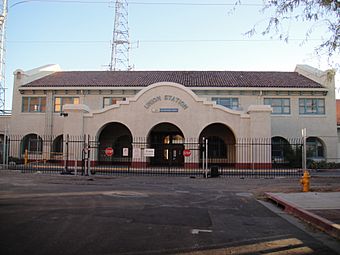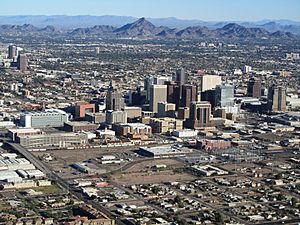Union Station (Phoenix, Arizona) facts for kids
Quick facts for kids
Phoenix Union Station
|
|||||||||||||||||||||||||
|---|---|---|---|---|---|---|---|---|---|---|---|---|---|---|---|---|---|---|---|---|---|---|---|---|---|

The station in 2014.
|
|||||||||||||||||||||||||
| Location | 401 W. Harrison St. Phoenix, Arizona United States |
||||||||||||||||||||||||
| Coordinates | 33°26′39″N 112°04′44″W / 33.44417°N 112.07889°W | ||||||||||||||||||||||||
| Owned by | Sprint Corporation | ||||||||||||||||||||||||
| Line(s) | Union Pacific Railroad | ||||||||||||||||||||||||
| Tracks | 1 | ||||||||||||||||||||||||
| History | |||||||||||||||||||||||||
| Opened | 1923 | ||||||||||||||||||||||||
| Closed | June 3, 1996 | ||||||||||||||||||||||||
| Former services | |||||||||||||||||||||||||
|
|||||||||||||||||||||||||
|
Union Station
|
|||||||||||||||||||||||||

North Side of Union Station Phoenix, Arizona
|
|||||||||||||||||||||||||
| Location | Fourth Ave. and Southern Pacific RR tracks, Phoenix, Arizona | ||||||||||||||||||||||||
| Area | 1 acre (0.40 ha) | ||||||||||||||||||||||||
| Built | 1923 | ||||||||||||||||||||||||
| Architect | Peter Kiewit | ||||||||||||||||||||||||
| Architectural style | Mission Revival | ||||||||||||||||||||||||
| MPS | Phoenix Commercial MRA | ||||||||||||||||||||||||
| NRHP reference No. | 85003056 | ||||||||||||||||||||||||
| Added to NRHP | November 25, 1985 | ||||||||||||||||||||||||
Phoenix Union Station is a historic train station located in downtown Phoenix, Arizona. It served as a busy hub for train travel for many years. Until 1996, it was an Amtrak station, meaning passenger trains stopped there regularly. It also served trains from the Santa Fe and Southern Pacific Railroad companies.
The station was a stop for famous Amtrak trains like the Sunset Limited (which traveled between Los Angeles and New Orleans) and the Texas Eagle (which went from Los Angeles to Chicago). Today, Phoenix Union Station is listed on the National Register of Historic Places, recognizing its importance in history.
Contents
Station Design and Style
Phoenix Union Station was built in 1923. It was a joint project between the Santa Fe and Southern Pacific Railroads. The station is a great example of Mission Revival architecture. This building style was popular from the late 1800s to the 1920s.
Key Features of Mission Revival
Buildings in the Mission Revival style often have certain looks. Phoenix Union Station shows these features clearly:
- Stucco walls: These are walls covered in a special plaster.
- Arcades: These are rows of arches, often found along walkways.
- Red tiled roofs: The roofs are covered with distinct red tiles.
- Curvy gables: These are the upper parts of the walls that follow a curved shape.
- Large piers: These are strong, thick supports, like columns.
The station's main waiting room is two stories tall. It has a high, beamed ceiling and original wooden furniture. The building also had long, low wings with arches. These areas were once open for passengers but have since been enclosed.
When it opened, the station was called a "Monument to the progressiveness and prosperity of the valley." It helped bring many tourists to Phoenix and made the city more well-known across the country.
A Look Back at History
Phoenix Union Station was officially started on September 16, 1922. It was built by the Robert E. McKee Construction Company. The idea for this "union station" came from an order. Railroad companies were told to combine their separate stations in downtown Phoenix into one main station.
Building the Station
The main station building is quite large. It measures 475 feet long and 74 feet wide. Next to it, there was also a Post Office building. The entire station was built using strong materials like steel and reinforced concrete. It cost about $556,000 to build, which was a lot of money back then!
Peak of Train Travel
In the years during and after World War II, train travel was very popular. Phoenix Union Station was incredibly busy, sometimes seeing as many as eighteen trains a day! Many different trains used the station, connecting Phoenix to other major cities.
- Santa Fe trains went to places like Parker, Barstow, and Los Angeles.
- The Hassayampa Flyer connected Phoenix to other major train routes.
- The Southern Pacific operated the Sunset Limited train. This train ran between Los Angeles and New Orleans.
- Other trains like the Golden State Limited connected Phoenix to Chicago.
Phoenix Union Station was the main way people arrived and left the city for many years. It served millions of passengers. It also hosted many special events and celebrations.
In 1995, the year before Amtrak stopped service, over 21,000 passengers used the station.
After Regular Service Ended
Even after regular Amtrak service stopped in 1996, the station still saw some special trains. The Olympic Torch train has stopped there twice. Tourist trains, like the GrandLuxe, have also used Union Station for special trips.
In 2000, the Arizona Department of Transportation held an event called "Transpo 2000" at the station. They showed off a modern Talgo train, giving people a glimpse of future rail travel.
Special Recognitions
Phoenix Union Station has received important historical recognitions:
- It's listed on the National Register of Historic Places.
- It's also on the Phoenix City Register, showing its importance to the city's history.
Current Status
Today, no regular passenger trains stop at Phoenix Union Station. However, there have been discussions and efforts to bring passenger train service back to Phoenix.
Nearby Train Services
While Phoenix Union Station isn't active, you can still catch Amtrak trains not too far away:
- The Sunset Limited train operates three times a week from Maricopa. Maricopa is about 30 miles south of downtown Phoenix.
- There are shuttle services that connect Phoenix to the Maricopa train station.
- Many Phoenix passengers also travel to Tucson to catch the Sunset Limited, as Tucson has a direct Amtrak station.
- Amtrak's Southwest Chief train runs through Flagstaff daily. There are shuttle services from Phoenix to connect passengers to this train in Flagstaff.
Public Transportation Nearby
The closest Valley Metro Rail station to Union Station is called City Hall. It's about half a mile away, making it easy to reach by walking.
Images for kids



